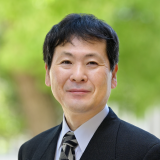Degree
-
Doctor (Engineering) Thesis ( 1997.3 Osaka University )
Updated on 2025/05/08

Doctor (Engineering) Thesis ( 1997.3 Osaka University )
Electron Optics
Manufacturing Technology (Mechanical Engineering, Electrical and Electronic Engineering, Chemical Engineering) / Measurement engineering / Electron Optics
Osaka University Department of Electronic Engineering Graduated
1986.4 - 1990.3
Osaka University Department of Electronic Engineering Master's Course Completed
1990.4 - 1992.3
Osaka University Research Assistant
1992.4 - 1998.3
Osaka University Research Assistant
1998.4 - 2003.3
Osaka University Research Assistant
2003.4 - 2004.10
Osaka University
2004.11 - 2007.3
Osaka University Associate Professor
2007.4 - 2020.3
Fukui University of Technology Professor
2020.4 - 2023.3
Osaka University
2020.4
Fukui University of Technology Professor
2023.4
Land Radio Engineer (1-2 class)
Chief Person of Radiation Handling (first and second kind)
Hygiene Engineering Hygiene Manager
X-ray Work Chief Person
Gamma Ray Penetration Photography Work Chief Person
Low-Aberration ExB Deflector Optics for Scanning Electron Microscopy Reviewed
Momoyo Enyama, Jun Yamasaki, Ryuji Nishi, Hiroyuki Ito
Microscopy 72 ( 5 ) 399 - 407 2023.10
Application of ultra-high voltage electron microscope tomography to 3D imaging of microtubules in neurites of cultured PC12 cells Reviewed
T. Nishida, R. Yoshimura, R. Nishi, Y. Imoto, Y. Endo
Journal of Microscopy 278 ( 1 ) 42 - 48 2020.4
Study on higher performance of imaging and observation system in ultrahigh voltage electron microscopy
Ryuji Nishi
1997.3
Educational Applications of Network tele-microscopy Using Tatara Steelmaking Specimens
K. Yamamoto, S. Shimbasi, T. Nagase, I. Seki, R. Nishi and S. Ichikawa
2024.11
Network tele-microscopy in cities and regional areas Invited International conference
T. Nagase, M. Yamashita, M. Todai, R. Nishi, S. Ichikawa
The 10th TKU-ECUST-KIST-OMU-UH-IHU-KMITL-UTAR-TNU-HUIT Joint Symposium on Advanced Materials and Applications (JSAMA-10) 2024.10 JSAMA-10, East China University of Science and Technology
Artificial Intelligence Compatible Charged Beam Optical System International conference
Hiroyuki Ito, Nishi Ryuji, Jun Yamasaki
11th Conference on Charged Particle Optics (CPO-11) 2024.10 CPO-11 Organizing Committee
Three-dimensional reconstruction of surface morphology of a polycrystalline dendrite particle using bright-field TEM images International conference
Shinya Mizuno, Takeshi Nagase, Ryuji Nishi and Jun Yamasaki
11th Conference on Charged Particle Optics (CPO-11) 2024.10 CPO-11 Organizing Committee
Network tele-microscopy observation system in Research Center for Advanced Metallic Materials at University of Hyogo and Hyogo Prefectural Institute of Technology International conference
K. Yamamoto, T. Nagase, M. Yamashita, R. Nishi, S. Ichikawa
4th Joint Symposium on Advanced Mechanical Science and Technology 2024.9 University of Hyogo
Virtual Reality Experiments of Electronic Circuits using TinkerCAD-circuits
Noriyuki Kimura, Ryuji Nishi
2024.8
Shinya Mizuno, Takeshi Nagase, Ryuji Nishi, Jun Yamasaki
2024.6
Examples of remote observation by network tele-microscopy
Koh Yamamoto, K. Sato, A. Sakota, D. Yamaguchi, Takeshi Nagase, Michiru Yamashita, Ryuji Nishi, Satoshi Ichikawa
2024.6
Examples of network tele-microscopy observation in metallic glasses and amorphous alloys
2024.5
2024.3
2024.3
Network tele-microscopy at University of Hyogo and Hyogo Prefecture Institute of Technology
Takeshi Nagase, Daichi Yamaguchi, Koh Yamamoto, Michiru Yamashita, Ryuji Nishi, Satoshi Ichikawa
The 66th Symposium of The Japanese Society of Microscopy 2023.11
Electron Microscope Observation on Spheroidal Graphite Cast Irons by Network Tele-Microscopy at Shimane Prefec-ture
Takeshi Nagase, Ozoe Nobuaki, Toru Maruyama, Satoshi Ichikawa, Ryuji Nishi
The 79th Annual Meeting of The Japanese Society of Microscopy 2023.6
Low-Aberration ExB Deflector Optics for Scanning Electron Microscopy
Momoyo Enyama, Ryuji Nishi, Hiroyuki Ito, Jun Yamasaki
The 79th Annual Meeting of The Japanese Society of Microscopy 2023.6
K. Sato, T. Nagase, T. Maruyama, S. Ichikawa, R. Nishi
2023.5
T. Nagase, S. Ichikawa, R. Nishi
2023.5
T. Tatematsu, T. Nagase, R. Nishi and S. Ichikawa
2022.11
T. Sanuki, T. Nagase, R. Nishi and S. Ichikawa
2022.11
K. Sato, T. Nagase, T. Maruyama, R. Nishi and S. Ichikawa
2022.11
K. Yamamoto, T. Nagase, A. Yamaguchi, A. Takeuchi, Y. Yanagitani, T. Yamasaki, T. Imaki, R. Nishi, and S. Ichikawa
2022.11
Digital Signal Processing
Electron Beam Nano Imaging
Electronic Circuit II
11th International Conference on Charged Particle Optics International contribution
Role(s): Planning, management, etc., Panel moderator, session chair, etc.
Organizing Committee for CPO-11, Yoichi Ose ( Fukui Prefecture International Exchange Hall ) 2024.10